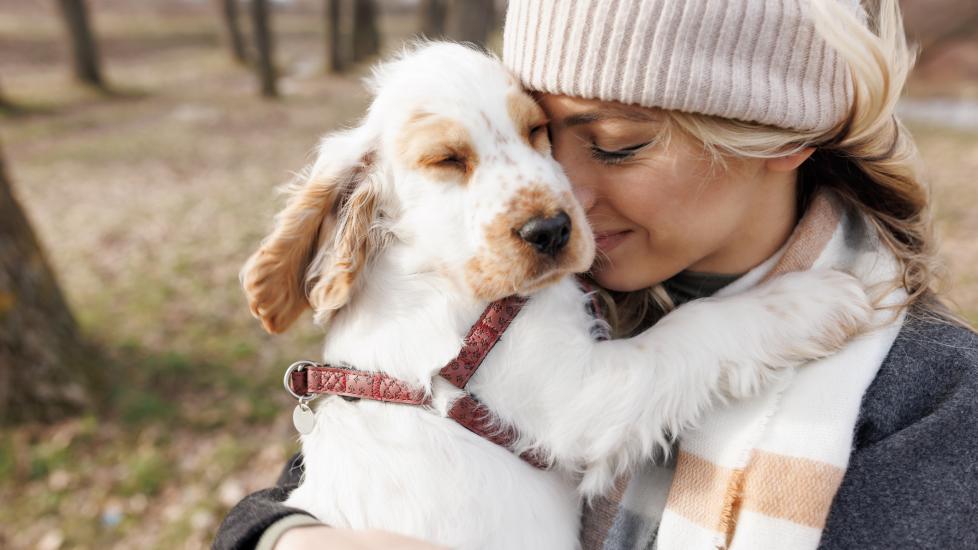4 Ways to Reduce Anxiety in Your New Puppy
Bringing home a new puppy is a very exciting time for a family, but it can also be very stressful, especially for your puppy.
Even well-socialized puppies coming from a reputable breeder will have some anxiety after separation from their littermates and being placed in a new environment.
Puppies from a shelter often have to deal with even more emotional and physical change in their young lives, depending on their history prior to the shelter.
Anxiety in a new dog or puppy is very normal, but if left unmanaged (or if managed inappropriately) it can result in a dog with separation anxiety or other unwanted, long-term behaviors.
Here’s how to set your new family member up for success in their new home.
What Causes Anxiety in a New Puppy?
First, it’s important to recognize what might trigger anxious behaviors. Keep in mind that puppies are all individuals, and your puppy may or may not be affected by the following situations.
Separation/Being Alone
Most puppies come to a new home after eight weeks of constant contact with their mothers, littermates, or pet parents.
They may even have never been alone at any time. This could result in anxious behaviors when you leave the room or house, or at night when everyone else is asleep.
New Sounds
It’s easy to see why loud, startling sounds like thunder, shouting, or a vacuum cleaner might cause some anxiety, but other sounds can affect your new puppy as well.
Puppies have very sensitive hearing, and sounds as innocuous to us as a ceiling fan or bacon frying have been known to trigger fear responses in dogs who haven’t heard them before.
Overstimulation
Even a confident puppy may be overwhelmed by too many new things at once.
New sounds or new people may be fine on their own, but combining these stressors may push your puppy from comfortable to fearful.
Genetics and Health Conditions
Sometimes, anxiety isn’t related to the environment.
There are a few studies that suggest many behaviors have a genetic component. For example, certain breeds (like Wheaten Terriers and German Shepherds) may be more prone to noise-related anxiety due to their excellent hearing.
Similarly, puppies with health conditions that affect their hearing or vision—or cause pain and discomfort—may be more anxious.
Make sure to have your new puppy evaluated by a veterinarian so that they can diagnose these conditions early.
Even though your puppy may be more prone to anxiety due to genetic or health reasons, that doesn’t mean they can’t be trained to be confident dogs. It just means you may have to work on more specific aspects of anxiety.
How To Tell if Your Puppy Is Anxious
Several behaviors can be seen in anxious puppies. Some will show only one or two of these behaviors, while others may show all of them.
Behaviors that may indicate your puppy is anxious or fearful are:
-
Vocalizing (whining, barking, crying)
-
Hiding, reluctance to play
-
Decreased appetite/reluctance to take treats
-
Frequently wanting to be held or picked up
How You Can Help Your Anxious Puppy
When you are dealing with an anxious puppy, remember that some anxiety during the transition to a new home is normal.
Patiently help your puppy through this transition by providing a stable and loving environment.
Though particularly fearful puppies may need more individualized programs, the following steps will get most puppies on the right track.
1. Start With a Calm Environment
For the first week or so, avoid large gatherings with lots of unfamiliar people.
Make sure that children (and adults) in the family know to keep their voices down around their puppy.
Pheromone products like Adaptil® may help emphasize this calm environment, mimicking the pheromones released by mother dogs.
2. Set a Routine and Clear House Rules
Just as you want to know what to expect from your puppy, they want to know what to expect from you!
Having a consistent routine for meals, walks, crate training, and potty training will help your puppy ease into their new life faster. Make sure that the whole family is using the same commands and reward systems.
3. Make Sure Your New Puppy Doesn’t Feel Alone
A new puppy may benefit from having their sleeping crate in a bedroom, where they can still hear you and feel close to their family.
It may benefit your puppy to have several crates throughout the house so that this space isn’t associated with being left alone.
Though you may eventually want to allow your dog to sleep with you at night, it’s important that puppies are initially crate-trained at bedtime.
This allows them a safe, consistent den to sleep in when home alone, during unexpected events, and during travel.
It’s easier to allow a crate-trained dog new luxuries than trying to create boundaries in the future with an adult dog who is used to sleeping in your bed.
4. Attention, Activity, and Play
A calm environment and steady routine don’t mean that your puppy should be ignored. While trying to stay within those guidelines, it’s important to keep your puppy involved in family activities.
Most puppies will benefit from a variety of non-destructible toys to choose from, like those from Kong® or Benebone®.
Be patient with barking, accidents, and other unwanted behaviors while your fur baby is learning.
Keeping them close by can help you identify and reward good behaviors immediately, which will make them even more likely to do them again.
Keep some of their kibbles in a wearable pouch so that you always have a reward on hand if your puppy sits calmly, lies down, or performs other commands.
If your puppy continues to show fearful behaviors despite these interventions, ask your veterinarian for advice.
They will be able to help you rule out any medical causes of unwanted behaviors and point you toward further resources for positive reinforcement training.
Featured Image: bojanstory/E+ via Getty Images
